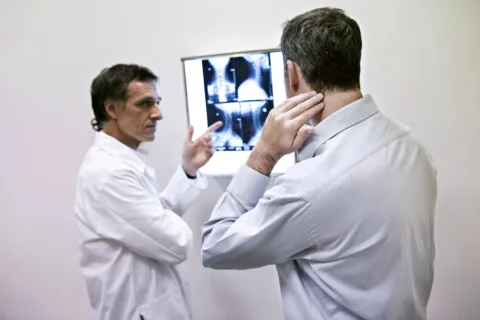Your back hurts and you’re not quite sure what to do. You ask a few friends and one of them suggests a chiropractor. But, you’ve never been to one and you wonder what happens the first time you visit.
As a chiropractor, I like to make my new patients feel comfortable about their first appointment with me.
Here’s what you can expect on your first visit to a chiropractor…
How do you know if you have pain that a chiropractor can fix?
The first thing you should know is that back pain is a good reason to see a chiropractor — in fact, it’s one of the most popular reasons that people visit chiropractors.
But the truth is… you can go to a chiropractor when you do not feel any pain at all.
Chiropractic adjustments are designed to put the spine back into its ideal alignment — so it’s perfect for maintenance and for repair.
How can I tell if my body is out of alignment and needs to be adjusted?
If you have misalignment in your body, you could have pain in your lower back, mid-back, or in your neck.
Most people have some misalignment — simply because we favor one side of our body over the other.
Here are some other issues that chiropractors can help fix:
- Arthritis
- Carpal tunnel
- Headaches and migraines
- Neck pain
- Whiplash
- Tendonitis
- Sprains and strains
- Allergies and asthma
- Sciatica
- Bursitis
- Scoliosis
- Stenosis
- Pain from pregnancy
How do I plan for my first chiropractic visit?
Most first-time patients make their appointments over the phone.
At that point, the experience will be the same as other offices. Someone will answer the phone and take necessary information — like your name, phone number, and physical problem.
Most offices will ask if you have insurance, but not having insurance shouldn’t keep you from visiting a chiropractor.
The first chiropractic visit is usually the least expensive, and many chiropractors have special rates for first-timers. Don’t hesitate to ask about first-time appointment specials!
What happens at the first appointment?
When you arrive at the chiropractor’s office, you will most likely be given a form to fill out that summarizes your medical history.
Chiropractors also have custom forms where you:
- Rate your physical health
- Explain any injuries you’ve had
- Share where your current pain is
The office staff might take x-rays or photos — so you can see misalignments. Of course, you can ask not to have x-rays taken, but they give the chiropractor the best view of your spine.
The office staff might use other tools to measure your range of motion. This gives the chiropractor baseline data to use — in order to see growth and progress, if you decide to get regular chiropractic care.
After your paperwork is completed and you have been assessed by the office staff (or a medical assistant), you will get to meet with the chiropractor.
As seen in this video, it’s important for you to share how you are feeling, when the pain started, and what may have triggered it:
The chiropractor will look at your paperwork, as well as the measurements, x-rays, and photos.
You will most likely have an adjustment at the end of your first chiropractic visit.
What happens when the chiropractor does an adjustment?
There are different types of adjustments — and it is perfectly ok to ask about the way the chiropractor will adjust you.
The manual adjustment involves the chiropractor putting their hands somewhere on your spine to force some movement. The chiropractor will tell you exactly how to sit, stand, or lay and when to inhale or exhale during the procedure.
The adjustment will be near the location of your pain — but you might also have other adjustments in areas that the chiropractor can see are misaligned.
Some people do not like manual adjustments, so chiropractors have other tools at their disposal that effectively do the same thing. For example, some chiropractors have tables that move. Others use small machines that apply pressure, but without the same force as a manual adjustment.
In some cases, the area that is adjusted might feel tender for a day or two. Your chiropractor will advise you to use ice and heat to treat the tenderness.
Are future visits required?
Before you leave, your chiropractor will give you a recommendation for future visits.
If the problem is chronic, they will advise you to come several times each week. Then, as the pain dissipates and your body gets back to optimal alignment, you will not need to come as often.
If you don’t have insurance, the office staff will talk to you about payment plans. The average cost of a chiropractic visit in the U.S. is $65 — ranging from $34 on the low end to $160 on the high end.
Low back pain initiated with a doctor of chiropractic (DC) saves 40% on health care costs when compared with care initiated through a medical doctor (MD), according to a study that analyzed data from 85,000 Blue Cross Blue Shield beneficiaries in Tennessee over a 2-year span. The study population had open access to MDs and DCs through self-referral, and there were no limits applied to the number of MD/DC visits allowed and no differences in co-pays. Researchers estimated that allowing DC-initiated episodes of care would have led to an annual cost savings of $2.3 million for BCBS of Tennessee. Source
Some chiropractic offices have massage therapists that can help with your healing. Your chiropractor might recommended regular massages — especially if it fits into your budget.
Your future chiropractic appointments will include adjustments that the chiropractor recognizes as helpful. The depth of each adjustment will be determined by your body’s reaction to them.
This chiropractic video reveals why chiropractors encourage you to schedule regular chiropractic visits:
How will I know when my body is back in alignment?
Every patient requires a different number of adjustments before the chiropractor can tell if the procedures are working.
One is whether you are still in pain, or not.
X-rays can help the chiropractor see if your spine is realigning, but there are other ways, too:
- Most chiropractors can visually see if your body is realigning by looking at how well your heels align when you are in a prone position.
- The chiropractor can also re-evaluate your range of motion to see if that has improved.
- A chiropractor can see how you carry stress in your body — and if that changes, then the adjustments are working.
If your body is in poor shape, you might have to go to the chiropractor for maintenance for the rest of your life. On the other hand, some people only need a few months of care to see significant improvement. Everyone’s body is different.
Your chiropractor will have a good idea of how many visits you need — after you’ve had a few visits.
How is chiropractic care better/different than taking meds for aches & pains?
Chiropractic care is a healthy alternative to taking medication for your aches and pains.
Most pain medication has some type of side effect, even the mildest over-the-counter options. And the prescription options can be addicting.
Most see a reduction in pain after only a few visits to a chiropractor — and you don’t have to worry about the side effects like stomach pain, itching, or addiction.
Dr. Brent Wells, D.C. offers patient-centered, personalized, and innovative chiropractic care. A California native, he and his wife Coni moved to Alaska in 1998 where he started his practice, Better Health Chiropractic in Juneau — serving Wasilla, Anchorage, and the surrounding communities. Dr. Wells is a proud member of the American Chiropractic Association and the American Academy of Spine Physicians.









